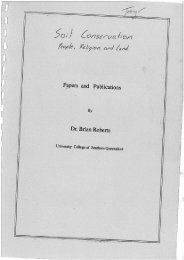western-queensland-gardening-guide.pdf - South West NRM
western-queensland-gardening-guide.pdf - South West NRM
western-queensland-gardening-guide.pdf - South West NRM
Create successful ePaper yourself
Turn your PDF publications into a flip-book with our unique Google optimized e-Paper software.
Suitable species<br />
This is a big subject and certainly in the ABC Radio listening area there is a big range<br />
of soils. In general the pH level is high (which is called alkaline). The soil types vary<br />
from heavy clay, light clay, sandy clay through to the so-called red country. I would<br />
consider <strong>gardening</strong> in the red country to be like living in heaven. All this soil<br />
variation brings problem of dryness, water problems and hot winds (and sometimes<br />
cold wind). My opinion of wind is that if you have everything else right (species,<br />
etc) wind can be of benefit in strengthening your plants.<br />
The best way to select species that will grow for you is to look around your area at<br />
what is doing well, whether it be at Roma, Cunnamulla, Longreach, Hughenden,<br />
Birdsville, the Gulf, Alpha or anywhere in between.<br />
at size tree or shrub to plant<br />
I favour so-called tube stock. These are a 2 inch x 4 inch pot which helps develop a<br />
strong root structure. They suit planting straight into the ground and they are<br />
cheaper to buy and transport.<br />
Some people walking into a nursery want a tree yesterday (or the week before) so<br />
they buy the tallest in a big pot for fifteen times the price of a tube. Particularly with<br />
natives, these plants can only get so big by being in pots too long. A native naturally<br />
wants to get its roots down, but in a pot they can only go round and round. With the<br />
Longreach Council I have planted a tube beside an advanced plant and the tube has<br />
gone on to be a ten times better plant.<br />
at size hole to dig<br />
There is a theory that you need to dig a big hole and fill it with good soil and plant<br />
your tree. I must admit that in some cases this works. Particularly if the hole is big<br />
enough and there is reasonable sub-surface drainage; but in reality the filled hole<br />
acts like a big pot and the plant spends its life in this restricted introduced material.<br />
1 like, where possible, to rip and cross-rip new planting areas. If a grader cannot be<br />
used a post hole digger often can, but, as you know, the sides are often compacted<br />
and made so hard that roots cannot penetrate easily. The solution is to dig several<br />
holes as close together as possible and push the undug areas in with a crowbar and<br />
then shovel all the dirt back in the hole. With experience you will find species most<br />
suited to your hole preparation technique (or lack of it).
















